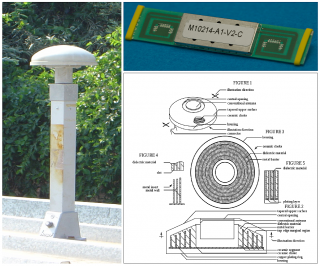If you wish to contribute or participate in the discussions about articles you are invited to contact the Editor
Antennas
| Receivers | |
|---|---|
| Title | Antennas |
| Author(s) | GMV |
| Level | Advanced |
| Year of Publication | 2011 |
From a user prespective, antennas are the main interface between the GNSS Space Segment (the satellite constellations) and the User Segment (GNSS receivers), as they are responsible for capturing the L-band signals transmitted from space. Antennas requirements can range from gain vs. azimuth and elevation, mutipath and interference rejection, or stability of the electrical phase center, to size, shape and environmental constraints. Due to the characteristics of GNSS systems, receiver antennas are typicaly Right-Hand Circularly Polarized[1] (RHCP) antennas, and the spacial reception pattern is near hemispherical: this configuration enables user reception of satellite signals in any azimuthal direction, and from zenith to horizon, thus maximizing satellite visibility.
Antenna types
Different applications may require different types of antenna design, technology and location[2]. In fact, as show in Figure 1, antennas can range from large roof-mounted antennas (e.g. for a static open sky view) to embedded antennas in receiver boards (e.g. for mobile handheld devices), and the most common types are:
- Patch Antennas: Patch antennas are the most common antenna type, as they are used in handheld mobile devices such as portable navigation devices and smartphones. The antenna is buit as a low-profile thin microstrip (i.e. patch), suitable for small form-factor devices.
- Dome Antennas: As the name suggests, dome antennas are housed in a hemispherical-like dome, and are seen in several roof-mounted installations.
- Helical Antennas: Helical antennas are typicaly built as a conducting wire around a cilindrical core, in a helix form, down to a ground plane. In GNSS receivers, the helix antennas can be used as directional antennas, with a radiation pattern along the axis of the antenna.
- Choke Ring Antennas: A choke ring antenna design consists in sorrounding a central antenna with several concentric conductive rings, enclosed in a protective dome. Its design is notable for the ability to reject multipath and low elevation signals (including reflections on the ground).
- Phased-Array Antennas: Phased-array antennas are mostly used for military or high-end applications, and consist of numerous antenna elements arranged in an array pattern. Each signal from an antenna in the array can be processed by introducing dynamic phase shifts, and when the outputs of the array are summed, the effective radiation pattern can be maximized in some directions and nulled in other (e.g. to insert nulls in the antenna pattern to adjust to jamming threats).
- Parabolic Antennas: Resembling popular TV and communications satellite dish antennas, parabolic antennas use a parabolic reflecting surface to direct the radio waves. The parabolic antenna is highly directive, so RF signals comming from the satellites can be received from one particular direction only. Its directive build structure and high gain make this type of antenna suitable for Ground Segment stations, such as monitoring or uplink stations.
Characteristics
Antennas used in GNSS receivers are targeted at capturing L-band signals originating from satellite constellations, so care must be taken when matching design specifications in terms of signal bandwidth, center frequency, desired response, transfer function, and electromechanical factors.
Typical radiation pattern coverage is around 160º, resulting in low gain for signals comming in at low elevation angles, as shown in Figure 2 for a patch antenna. This pattern aims at maximizing the gain at zenith, decreasing to near unity at an elevation angle of around 10º-15º, and to negative gains below the elevation threshold (sometimes refered to as elevation mask). At zenith, the ratio of the vertical electric field to the horizontal electric field response is near unity, and this ratio is referred to as the axial ratio[3].
Another important design factor for antennas is the phase center. In fact, when a receiver determines a position solution, it is actualy estimating the position of the electrical phase center of the antenna, where the signals are captured, regardless of the distance from the antenna the receiver device actualy is. This electrical phase center should not be mistaken with the physical phase center: although the latter can be observed and is a physical constant, the first may vary, depending on the direction of arrival of the received signal.
Front end connection
Related articles
References
- ^ wikipedia:Circular Polarization
- ^ wikipedia:Category:Radio frequency antenna types
- ^ For further details, see Kaplan, E.D. et al, "Understanding GPS: Principles and Applications", second edition, chapter 3, section 3.4.1.1.



